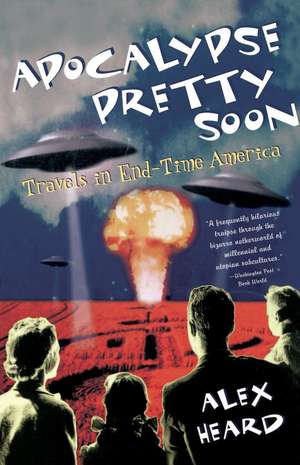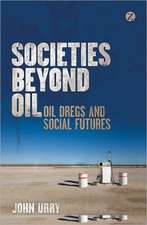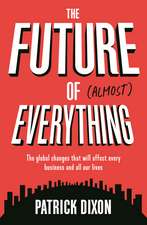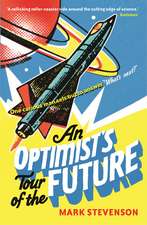Apocalypse Pretty Soon: Travels in End-Time America
Autor Alex Hearden Limba Engleză Paperback – 31 ian 2000
Amazing as it may seem, however, throughout this trenchant subcultural travelogue, Heard never stoops to ridicule his subjects. As one reviewer puts it, "Heard's real achievement may be that he makes us care--in a way that is more than voyeuristic--about the colorful characters he meets on the road to the new millennium. He takes these people seriously, allows his assumptions to be challenged, and lets himself find that some of their beliefs and fears reflect his own" (San Jose Mercury News).
Apocalypse Pretty Soon will appeal to science fiction fans and students of subcultures, as well as anybody interested in way-out alternatives to the brave new world.
Amazing as it may seem, however, throughout this trenchant subcultural travelogue, Heard never stoops to ridicule his subjects. As one reviewer put it, "Heard's real achievement may be that he makes us care--in a way that is more than voyeuristic--about the colorful characters he meets on the road to the new millennium. He takes these people seriously, allows his assumptions to be challenged, and lets himself find that some of their beliefs and fears reflect his own" (San Jose Mercury News).
Now in paperback, this book will have an audience well beyond "millenniamania," from science fiction fans to students of subculture, and anybody interested in way-out alternatives to the brave new world. -->
Preț: 116.55 lei
Nou
Puncte Express: 175
Preț estimativ în valută:
22.30€ • 23.26$ • 18.54£
22.30€ • 23.26$ • 18.54£
Carte disponibilă
Livrare economică 27 februarie-13 martie
Preluare comenzi: 021 569.72.76
Specificații
ISBN-13: 9780385498524
ISBN-10: 0385498527
Pagini: 368
Dimensiuni: 142 x 220 x 23 mm
Greutate: 0.45 kg
Editura: MAIN STREET
ISBN-10: 0385498527
Pagini: 368
Dimensiuni: 142 x 220 x 23 mm
Greutate: 0.45 kg
Editura: MAIN STREET
Notă biografică
Alex Heard is an editor at Wired magazine. He has also edited and written for The New York Times Magazine, Outside, The New Republic, Slate, and many other publications.
Extras
Welcome, Space Brothers
What would happen in a world, when upon impacted soil, an angel touches down to stay a while?
--from Forty Years of Love and Light, a video eulogy for Ernest and Ruth Norman, co-founders of the Unarius Academy of Science
On December 27, 1974, in a moment that must have cheered somebody up at the Los Angeles offices of the Internal Revenue Service, a completed IRS form 1023 arrived by mail from a California-based outfit called Unarius--Science of Life. Form 1023 is mandatory paperwork for groups seeking tax-exempt status, and one requirement is "a narrative description of the activities presently carried on by the organization." Most people keep that answer short and straight. (Why brag when you're asking for a favor?) The Unarians did too--by their standards--but their unique mission demanded a splash of Technicolor:
Planned and masterminded by millions of super-intelligent beings from higher worlds, Unariun [sic] Mission formally began in 1954. . . . [Its teachings] could most accuratly [sic] be described as containing more information, knowledge, and wisdom than would be contained in any known pricepts [sic] of human knowledge. This Interdimensional Science exist [sic] now in 30 bound volumes and was delivered to the earth world by Dr. Ernest L. Norman and his wife, Ruth E. Norman. . . . Here . . . can be attained the science of the future. . . .
The IRS doesn't require nonprofits to demonstrate that their work will benefit the United States government. Unarius tossed that in anyway, giddily bragging that it could help the country win the cold war.
"The Unariun Science could factually . . . place the United States far ahead of [the] U. S. S. R. in all scientific findings," the application said. Since the previous August, Ruth Norman had received "mental transmissions" from "over 159" departed luminaries, including "Albert Einstein . . . Iwan Petrovich Pawlow [sic] . . . Robert Oppenheimer, President John F. Kennedy, Eisenhower, T. Roosevelt, etc., etc." In the process she had recovered the lost secrets of the Tesla Tower, a 2,000-foot-tall wireless energy-transmission machine--attempted and abandoned on Wardenclyffe, Long Island, in the early 1900s by Nikola Tesla, the late, great engineering genius--that the Normans planned to build using "crystalline substance and gold."
"There are no limitation [sic]," the statement concluded, "to the great aid we can extend to the suffering humanity."
Unarius won its tax exemption, listing both Ernest and Ruth on its initial board of directors. This was rather a stretch in Ernest's case--he had died in 1971--but Ruth definitely made a mark. In 1975 she purchased a building in El Cajon, California, east of San Diego. There she nurtured a remarkably durable utopian group that has worked tirelessly ever since to spread her bizarre but joyous message about mankind's future, which she saw as one of imminent millennial salvation at the hands of "space brothers." Over the years, she attracted dozens of devoted students who helped Unarius find its place in a world that has tended (almost unanimously) to ignore or mock her prophecies, particularly her most famous one. In the mid-seventies she announced that sometime soon, thirty-three spaceships (representing thirty-two other worlds and Earth) would touch down in an interlocking stack near El Cajon. Each would contain infinitely wise extraterrestrials who were coming to launch a New Age university that would usher in perpetual peace, wisdom, and harmony.
To prepare the way, Ruth bought sixty-seven acres of land outside of town and put up a sign that clearly stated the parcel's function: welcome space brothers. At one point, so confident that she placed a substantial bet with a London bookie, she announced that the landing would happen in 1976, but when that prophecy failed she remained unruffled and came up with the year 2001. These pronouncements and flubs made Ruth something of a fringe-world superstar. At various times, print and television reporters from all over the world came to catch her act, which was jazzed up by her speaking style--a cheerful, high-pitched warble--and her wardrobe. As Queen Bee of Unarius, Ruth dressed the part, wearing gaudy gowns and tiaras assembled by loving Unarius students.
Ruth accomplished all this as a very old woman. She was born in 1900, so she was already seventy-four when Unarius began growing in the mid-seventies. At her death in 1993, Unarius's annual filings with the IRS showed a healthy bottom line. The group owns its headquarters, which includes a large meeting space where Unarius students gather for weekly classes, video-production facilities where the students make unintentionally kitsch dramas that bring Ruth's teachings to life (shown on cable-access channels all over the United States), and an endless stream of Unarius publications and books. Unarius's total assets in 1992 bettered $500,000. That's not much by the standards of, say, the Church of Scientology, but it's not bad compared with a more famous outfit whose teachings shared several basic themes with Unarius: Heaven's Gate. During the years that Unarius was attaining Rotarian plumpness, the followers of Marshall Herff Applewhite and Bonnie Lu Nettles were essentially vagabonds living out of cars and in cheap hotels.
As for Ernest Norman, dead or alive he deserved a place of honor on the Unarius roll of honor. Though Ruth's saucer prediction got the media attention, the primary interest of Unarius students, then and now, is a concept Ernest added to the mix in the fifties: "past-life therapy," the study of how your soul's (alleged) past physical incarnations affect you psychologically and spiritually in the present. Unarius students are taught that they've lived many times before in exotic civilizations like Atlantis, ancient Egypt, the planet Vixall, and a distant, long-ago galaxy called Orion. They also believe that by using recovered-memory techniques to examine these lives, they can work toward a more perfect self, a process known as "progressive evolution." In this scheme, the Normans have special distinction. They are both archangels (Ernest's archangel name was Raphiel, Ruth's was Uriel) who came to Earth out of sheer generosity to show debased humans how to advance to a higher level.
But alas, these facts don't fully convey the Unarius style, which was personified by Ruth Norman, a true American original who combined the couture sensibilities of a drag queen with the joi de vivre of a Frisbee-chasing Irish Setter. She translates best on film and videotape, but even on the printed page her strange vitality leaps out.
What would happen in a world, when upon impacted soil, an angel touches down to stay a while?
--from Forty Years of Love and Light, a video eulogy for Ernest and Ruth Norman, co-founders of the Unarius Academy of Science
On December 27, 1974, in a moment that must have cheered somebody up at the Los Angeles offices of the Internal Revenue Service, a completed IRS form 1023 arrived by mail from a California-based outfit called Unarius--Science of Life. Form 1023 is mandatory paperwork for groups seeking tax-exempt status, and one requirement is "a narrative description of the activities presently carried on by the organization." Most people keep that answer short and straight. (Why brag when you're asking for a favor?) The Unarians did too--by their standards--but their unique mission demanded a splash of Technicolor:
Planned and masterminded by millions of super-intelligent beings from higher worlds, Unariun [sic] Mission formally began in 1954. . . . [Its teachings] could most accuratly [sic] be described as containing more information, knowledge, and wisdom than would be contained in any known pricepts [sic] of human knowledge. This Interdimensional Science exist [sic] now in 30 bound volumes and was delivered to the earth world by Dr. Ernest L. Norman and his wife, Ruth E. Norman. . . . Here . . . can be attained the science of the future. . . .
The IRS doesn't require nonprofits to demonstrate that their work will benefit the United States government. Unarius tossed that in anyway, giddily bragging that it could help the country win the cold war.
"The Unariun Science could factually . . . place the United States far ahead of [the] U. S. S. R. in all scientific findings," the application said. Since the previous August, Ruth Norman had received "mental transmissions" from "over 159" departed luminaries, including "Albert Einstein . . . Iwan Petrovich Pawlow [sic] . . . Robert Oppenheimer, President John F. Kennedy, Eisenhower, T. Roosevelt, etc., etc." In the process she had recovered the lost secrets of the Tesla Tower, a 2,000-foot-tall wireless energy-transmission machine--attempted and abandoned on Wardenclyffe, Long Island, in the early 1900s by Nikola Tesla, the late, great engineering genius--that the Normans planned to build using "crystalline substance and gold."
"There are no limitation [sic]," the statement concluded, "to the great aid we can extend to the suffering humanity."
Unarius won its tax exemption, listing both Ernest and Ruth on its initial board of directors. This was rather a stretch in Ernest's case--he had died in 1971--but Ruth definitely made a mark. In 1975 she purchased a building in El Cajon, California, east of San Diego. There she nurtured a remarkably durable utopian group that has worked tirelessly ever since to spread her bizarre but joyous message about mankind's future, which she saw as one of imminent millennial salvation at the hands of "space brothers." Over the years, she attracted dozens of devoted students who helped Unarius find its place in a world that has tended (almost unanimously) to ignore or mock her prophecies, particularly her most famous one. In the mid-seventies she announced that sometime soon, thirty-three spaceships (representing thirty-two other worlds and Earth) would touch down in an interlocking stack near El Cajon. Each would contain infinitely wise extraterrestrials who were coming to launch a New Age university that would usher in perpetual peace, wisdom, and harmony.
To prepare the way, Ruth bought sixty-seven acres of land outside of town and put up a sign that clearly stated the parcel's function: welcome space brothers. At one point, so confident that she placed a substantial bet with a London bookie, she announced that the landing would happen in 1976, but when that prophecy failed she remained unruffled and came up with the year 2001. These pronouncements and flubs made Ruth something of a fringe-world superstar. At various times, print and television reporters from all over the world came to catch her act, which was jazzed up by her speaking style--a cheerful, high-pitched warble--and her wardrobe. As Queen Bee of Unarius, Ruth dressed the part, wearing gaudy gowns and tiaras assembled by loving Unarius students.
Ruth accomplished all this as a very old woman. She was born in 1900, so she was already seventy-four when Unarius began growing in the mid-seventies. At her death in 1993, Unarius's annual filings with the IRS showed a healthy bottom line. The group owns its headquarters, which includes a large meeting space where Unarius students gather for weekly classes, video-production facilities where the students make unintentionally kitsch dramas that bring Ruth's teachings to life (shown on cable-access channels all over the United States), and an endless stream of Unarius publications and books. Unarius's total assets in 1992 bettered $500,000. That's not much by the standards of, say, the Church of Scientology, but it's not bad compared with a more famous outfit whose teachings shared several basic themes with Unarius: Heaven's Gate. During the years that Unarius was attaining Rotarian plumpness, the followers of Marshall Herff Applewhite and Bonnie Lu Nettles were essentially vagabonds living out of cars and in cheap hotels.
As for Ernest Norman, dead or alive he deserved a place of honor on the Unarius roll of honor. Though Ruth's saucer prediction got the media attention, the primary interest of Unarius students, then and now, is a concept Ernest added to the mix in the fifties: "past-life therapy," the study of how your soul's (alleged) past physical incarnations affect you psychologically and spiritually in the present. Unarius students are taught that they've lived many times before in exotic civilizations like Atlantis, ancient Egypt, the planet Vixall, and a distant, long-ago galaxy called Orion. They also believe that by using recovered-memory techniques to examine these lives, they can work toward a more perfect self, a process known as "progressive evolution." In this scheme, the Normans have special distinction. They are both archangels (Ernest's archangel name was Raphiel, Ruth's was Uriel) who came to Earth out of sheer generosity to show debased humans how to advance to a higher level.
But alas, these facts don't fully convey the Unarius style, which was personified by Ruth Norman, a true American original who combined the couture sensibilities of a drag queen with the joi de vivre of a Frisbee-chasing Irish Setter. She translates best on film and videotape, but even on the printed page her strange vitality leaps out.
Recenzii
"A frequently hilarious traipse through the bizarro netherworld of millennial and utopian subcultures."
--Washington Post Book World
"Apocalypse Pretty Soon is a funny must-read for anyone looking for a respite from doom-and-gloom offerings currently on the bookstore shelves."
--Chicago Tribune
"Funny, unsettling, crank-packed...an all-American take on the looming exclamation point at the end of history."
--Entertainment Weekly
"Heard is an engaging writer: witty, not snide, not superior...turn to the chapter titled 'Death, Be Not in My Face,' read it, and I think you will agree: This is not simply silly stuff; this is the human comedy."
--Katherine Powers, Boston Globe
--Washington Post Book World
"Apocalypse Pretty Soon is a funny must-read for anyone looking for a respite from doom-and-gloom offerings currently on the bookstore shelves."
--Chicago Tribune
"Funny, unsettling, crank-packed...an all-American take on the looming exclamation point at the end of history."
--Entertainment Weekly
"Heard is an engaging writer: witty, not snide, not superior...turn to the chapter titled 'Death, Be Not in My Face,' read it, and I think you will agree: This is not simply silly stuff; this is the human comedy."
--Katherine Powers, Boston Globe
Descriere
Over a ten-year period, intrepid cultural traveler Alex Heard has been sojourning among America's most intensely religious and political believers. Now he offers a funny and frightening look at millennial, utopian, and futuristic subcultures.














